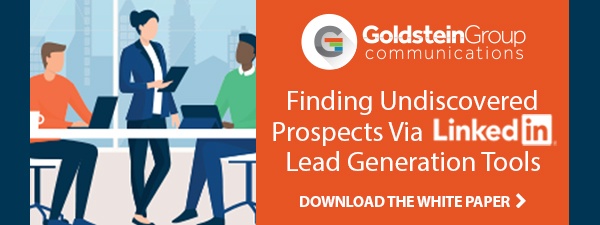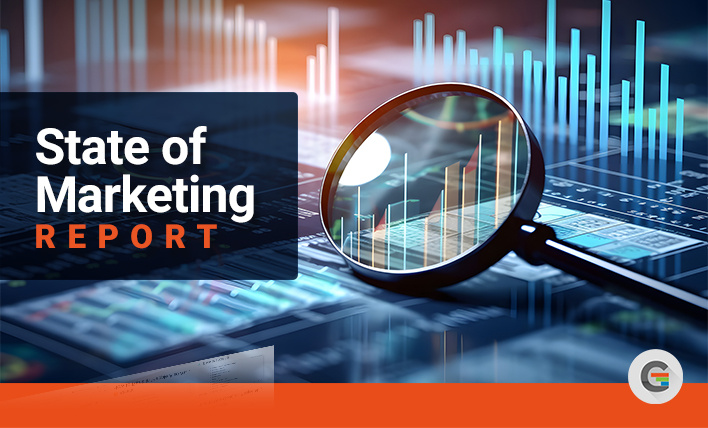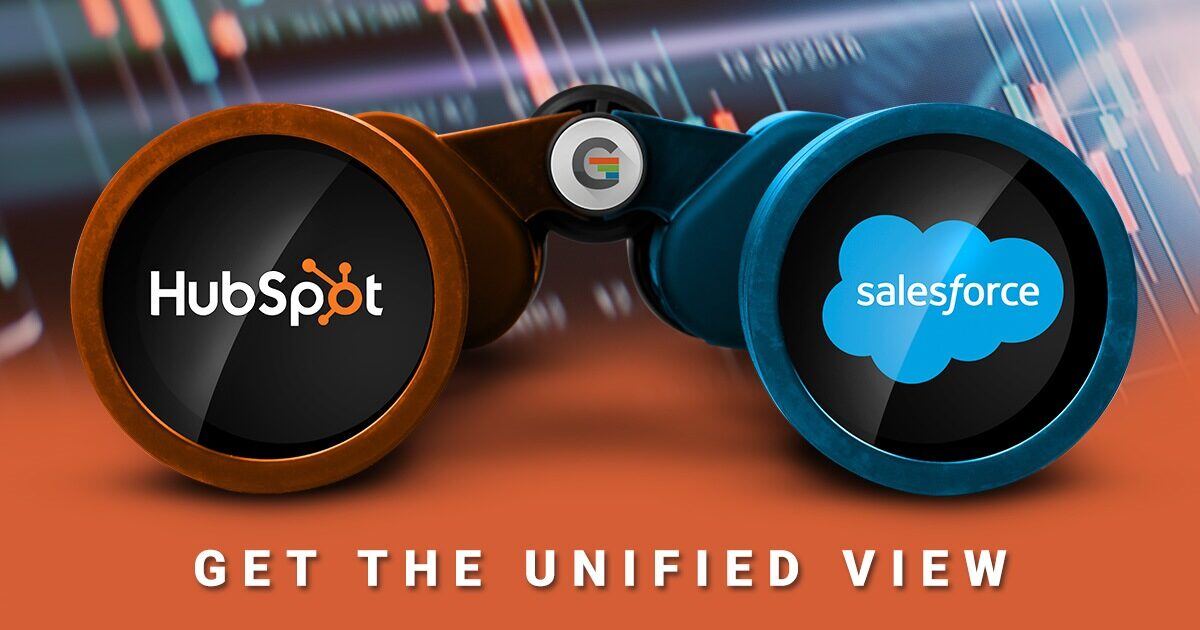Finding Undiscovered Prospects Via LinkedIn Lead Generation Tools
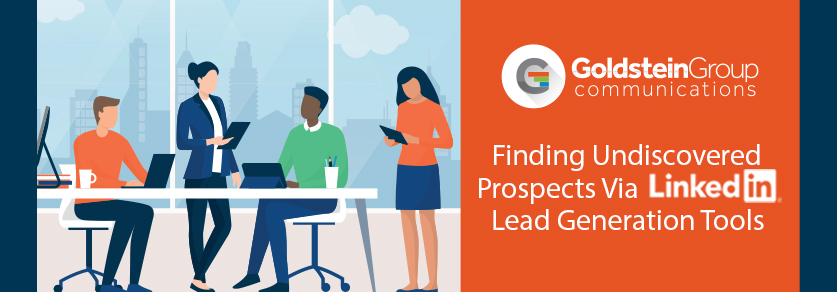
When many of our prospects are working from home and with many trade shows cancelled,  it’s even more of a challenge to engage potential customers. Where will you find the sales leads you need to keep your pipelines full? Increasingly, the answer for many B2B marketers is not just online, but on LinkedIn.
it’s even more of a challenge to engage potential customers. Where will you find the sales leads you need to keep your pipelines full? Increasingly, the answer for many B2B marketers is not just online, but on LinkedIn.
The challenge for any marketing campaign is to target your limited resources with as much precision and focus as possible. LinkedIn is the ideal platform for hyper-focused marketing, since your prospects have taken the time to do all the work for you!
- They’ve gathered together in special interest groups relevant to your business
- They’ve written profiles about themselves that identify what they’re responsible for buying
While your website is hard at work bringing people in to learn more about you, there’s no substitute for proactive outreach to targeted prospects. Thinking about doing more email marketing? Think as well about adding a LinkedIn strategy, since messages and ads delivered through LinkedIn stand out from email clutter and packed inboxes. And now that many decision-makers are spending more time in front of their computers, all the social media platforms are seeing a surge in traffic.
Whether to do LinkedIn marketing or not is no longer a matter of opinion. LinkedIn’s dominance in the B2B social media space is well documented:
- 80% of social media B2B leads come from LinkedIn
- 50% of B2B buyers use LinkedIn as a source for making purchasing decisions
- 75% of B2B buyers prefer to work with recommendations from their professional network
- 60% of LinkedIn users use the platform to look for industry insights
- LinkedIn has 675 million users; two new people join LinkedIn every second
In short, it’s the marketer’s dream: Relevant prospects looking for purchasing information and industry insights that you’re in a position to provide.
Right now, with trade show spending and travel being curtailed, most B2B marketers are realigning their budgets to invest more in digital marketing. According to a study from IEEE Globalspec, companies are moving money from shows into digital search/content programs (61%) because people are spending more time online now. You can see that on the chart below from one of the publishers – only 22% are decreasing digital marketing spend.
For B2B, social spending is concentrated on LinkedIn. In fact, that’s justified by the results in LinkedIn campaigns we’ve conducted.
- A healthcare industry Sponsored Content Campaign generated leads at just $22.22/lead, beating the average B2B benchmark of $133/lead
- A one-week campaign targeted at the cannabis industry produced leads at just $7.48
- One of our industrial campaigns turned in a cost/lead performance of $8.33
Regardless of the industry sector, LinkedIn campaigns help uncover qualified opportunities and contacts to engage. There are a variety of ways you can convert these stats and trends to your advantage – now!
There are three LinkedIn campaign options you should consider:
- LinkedIn lead-gen campaign to support Account-Based Marketing (ABM) campaigns (top 1-5 target companies) or account penetration campaigns. For instance, you may sell to one company location, but you’d love to take your solution to other parts of the same company that don’t know about you.
- LinkedIn targeted campaigns by title, industry, company, geography, etc… you know the profile of who you want to talk to; now you’ll use LinkedIn to reach them.
- LinkedIn InMail campaigns – a good option to supplement the email marketing campaigns you’re running.
The platform is different, but the rules for campaign success apply on LinkedIn as they do in any other digital marketing tactic. It’s especially important on LinkedIn, since campaigns that aren’t thought through well show poor results.
LinkedIn campaigns, or any social media campaign, provide targeted lead gen, but not lead gen in high quantities. It’s a supplement to your overall marketing program, so keep in mind that it’s not a principle driver of volume. You’ll use LinkedIn to augment your lead campaigns in a way that builds on your other activities, not replaces them.
Before you launch the campaign, start by addressing the same principles that drive success in all your marketing programs: message, list profile, execution.
Building a Great Campaign
Work with your product and sales team first, to complete the answers to the following questions. It will ensure you’re targeting the right prospects on LinkedIn, and sharpen your messaging into something that’s truly compelling and persuasive, rather than a “me-too” message.
- What are the “only” messages that apply to this campaign – “only” your company can do X; only your company can solve X; only your company can provide X
- What are the “switch” messages – what do we say to get someone to switch from a competitor to your company
- What “triggers” get people to first begin investigating/searching for a solution? What has happened/what precipitated the interest at that moment?
- What proof points do we have to show our superiority in this space?
- What barriers or customer objections do we have to overcome?
- What aspects of what we offer do customers “HAVE to have?” What features are just “nice to haves?”
- What will competitors say against us, and what is our response?
- What “sell against” messages do we use to cast doubt on our competitors’ solutions?
- Why do you win a deal/why do you lose a deal?
As a marketer, your job is not just to gather the answers, but push back on your leadership and colleagues if they give you me-too responses. People only respond to what will help them do their jobs better. If you’re talking around that, they’ll scroll right past your message.
Content Offer
You’ll need a strong content offer that addresses the message questions above and presents a solution to the pain point your customers are having.
And just as you’re avoiding non-differentiated “me-too” messaging, now it’s time to make sure you’re avoiding “me-messaging” in your content piece, whether it’s a white paper, video, infographic or webinar. Your content piece has to be tutorial in nature, either Top- or Middle-of-Funnel content “that teaches them something to do their jobs better.” It must provide them with information they need to solve the problem keeping them up at night.
Many companies lean toward promoting content pieces that focus on their companies, that talk about their solutions. With LinkedIn campaigns, that’s too early in the buying process for messages like that to take hold. They’re not typically asking in early stages who you are – they’re asking for information about whether a solution exists for the problem they’re trying to solve.
Keep the Buyer’s Journey in mind as you’re crafting your content offer. Prospects go through a series of questions, and if you skip a step, you’re likely to merely talk past them instead of engaging them.
- Do I have a problem?
- Is there a solution to my problem?
- Is your solution better than anyone else’s solution?
- Do I need to buy your solution now?
LinkedIn campaigns typically focus on the answer to questions #1-2, with information included toward the end that touch briefly on #3. Leading with #3 typically leads to sub-par results.
The title of your content piece is so very important. Our agency has learned over time that topics that begin with “How to” or “Learn How” tend to produce better quality leads.
List Profile
Now that you’ve honed your message and created a strong offer, you’re ready to launch! LinkedIn lets you build your target list very easily, and even provides a forecast on results you can expect.
Enter Campaign Manager, select Lead Generation Campaign, so you can use lead generation forms as part of your campaign. If you’re trying to create an awareness campaign and only seek impressions to an ungated piece of content, rather than leads, you can choose “website visits” instead of lead generation.

Then build the basic target profile descriptions you need and campaign parameters:
- Geography
- Title
- Company (name, industry, number of employees, etc)
- Date
- Keywords – in name and in skills or groups or profile that have the keyword and promote to members of that group

LinkedIn will forecast how the campaign will perform -- how many people your target includes, how many impressions you’ll get, how much the campaign will cost, and even how many clicks and leads you’ll likely receive. This information allows you to adjust the campaign, to make it longer or shorter in duration, broader or more narrow, to fit the budget and response you’re trying to produce.
In terms of budget, be sure to set both a daily and a total campaign cap, so you’re able to control the spend with no surprises!
You can also create a lead form for the offer. Again, the offer has to be strong enough to persuade prospects to enter their contact information in the form. For LinkedIn especially, you’ll keep the form as short as possible – name, email, title, company. Keep phone number fields off your campaign, since that’s too high a bar to ask prospects to complete in a LinkedIn campaign. It will just lead them to close out from the offer form.
List building is where the power of LinkedIn really comes to your benefit, because you have a variety of options. You can choose a list matching or “lookalike” program if you have a purchased list, prospect or customer list that you want to mirror, instructing LinkedIn to find and deliver your ad to unknown prospects that match exactly who you’re trying to reach. You can also create a campaign specifically to reengage with an audience who hasn’t clicked on your emails lately, using a fresh platform liked LinkedIn to deliver the message instead of cluttered email inboxes. We’ve also built campaigns that promote content specifically to an industry vertical.
Ad Formats
There are a variety of ad formats you can experiment with: single image ads, carousel ads, video ads, InMail ads or text/message ads that appear at the top of the page.
A single image ad is served up directly in the prospect’s LinkedIn “stream.” Carousels do as well, but you can choose a variety of images to fit an industry vertical, for instance, that incorporate movement to capture their attention.
You’ll see the same advantage with a video ad, which autoplays as they’re scrolling through their steam so the movement can grab their attention for a few seconds longer.
Message, or InMail, ads allow you to be very personal, one-to-one. They are sent from an individual, such as one of your salespeople, rather than from the company. We’ve used it to drive webinar signups with links inside the message to boost registration.
Text ads are highly visible ads with a message that appears at the top of the page, and on the right rail. The downside is that they can’t be tied to a lead generation campaign, only brand awareness.
You should experiment with all of these ad formats, to determine what works best for your audience and content types.

Mistakes to Avoid
You’ll come up with your own over time, of course, but here are a few of GGC’s “lessons learned:”
- Make sure to set a budget cap!
- Pick the right objective. If you’re really going to measure the campaign based on cost/lead, don’t launch any of the awareness campaign options.
- LinkedIn defaults to an automated bid option. This may be fine, but if you want to receive your leads in an accelerated time period, you may want to change that.
- Picking the wrong content offer will certainly depress your results. Make sure it’s tutorial, titled with a compelling theme, and doesn’t hint at any promotional content.
- Graphic mistakes, such as an ad that is too wordy, or the wrong message. It’s pretty hard to have a wordy LinkedIn ad, though, since there’s a very finite amount of space to work with.
- Maybe you want to get leads fast, so you want to change the timeline and budget to accelerate it.
- Don’t ask for too much information in the lead form. LinkedIn will autofill the basics, so make it as easy as possible for people to get to your content (and into your lead nurture program).
- Once they complete the form, make sure you’re sending them to the actual content piece itself, not another landing page that requires them to complete the form again!
Just as with any new campaign or martech tool, you’ll go through a few iterations to learn what works best for you. But you’ll enjoy it – it’s measurable, it provides instant feedback, and you can control your marketing spend with extreme precision!
Sidebar: Connected LinkedIn and Your CRM
It’s not part of lead gen advertising, but LinkedIn offers another component for powering your sales efforts: Integration with CRM.
By connecting a Team-Level Sales Navigator LinkedIn subscription ($103/month) to Salesforce (or another CRM), you can import contacts from LinkedIn into Salesforce for easier lead follow up. This also helps your marketing campaigns, since now those contacts with an email address can be included into your lead nurturing and drip email blasts.
In addition, if you prospect using the LinkedIn InMail feature, those InMails are automatically saved into the prospects Salesforce record.
Be careful: You don’t want to pull all of your Salesforce contacts into LinkedIn. Many have tens of thousands of contacts in their CRMs, and that creates too much unfiltered noise in your LinkedIn contact database.
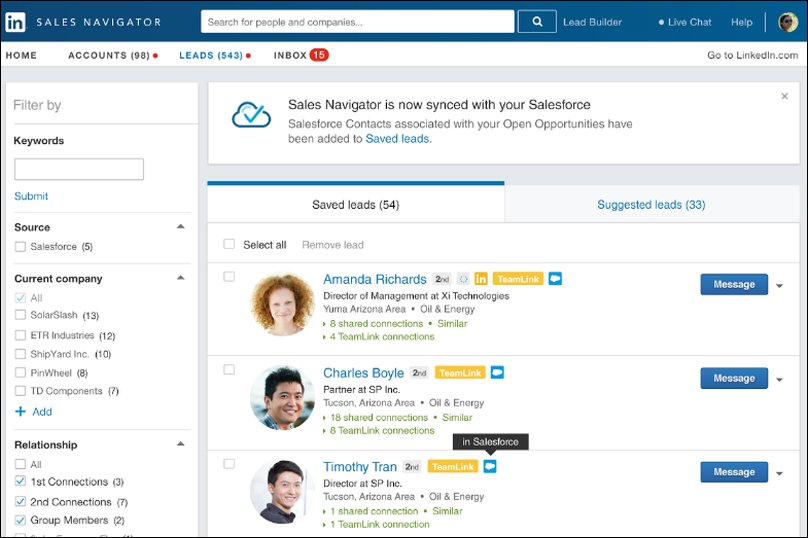

Want to share this with others? You can also get a copy of this as a printable pdf here:


